How To Change The World (Interview)

Greenpeace has been an integral part of the New Zealand landscape for over 30 years, with the bombing of The Rainbow Warrior in Auckland Harbour becoming one of this country’s defining moments. But how much do you really know about how Greenpeace was formed? Director Jerry Rothwell has assembled How To Change The World, a feature-length documentary about the formative years of Greenpeace which is set to screen at this year’s New Zealand International Film Festival. Based on the diaries of founder/leader Bob Hunter, How To Change The World explores the group dynamic that formed the now iconic ecology organization with contemporary interviews with all of the main players including Paul Watson and Patrick Moore, two idealistic young men who have since gone in opposite directions. Perhaps the film’s biggest draw in the newly-unearthed 16mm film footage that Greenpeace shot as they attempted to stop the slaughter of whales and seals in the early 1970s. The 13th Floor’s Marty Duda spoke with director Jerry Rothwell about the making of How To Change The World.
Listen to the interview with Jerry Rothwell here:
Or read a transcription of the interview here:
MD: I guess the first thing to ask is what brought you to that particular subject matter of making a film about the early days of Greenpeace?
JR: I guess for me it was sort of, probably the realization that this archive existed. I was doing some research in the Institute Of Social History in Amsterdam and I was down for a different project and kind of realized there was this treasure of 16mm footage that had been shot in the early Greenpeace boat and from there I sort of started reading the books of Robert Hunter who was Greenpeace’s first president and kind of the least presidential president you could…
MD: Yeah.
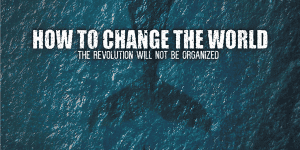 JR: His books are really kind of funny and sort of self-critical and I really fell in love with his writing and wanted that to be sort of the set… and with the way he kind of reflected on that period.
JR: His books are really kind of funny and sort of self-critical and I really fell in love with his writing and wanted that to be sort of the set… and with the way he kind of reflected on that period.
MD: Right.
JR: I guess sort of drawn to films that are about groups, I suppose, or I’m very interested in the dynamics of groups and social movements I suppose. So that’s what kind of drew me to…
MD: Oh okay. It seems like that particular period in history, kind of late 60s, early 70s, tt seems to be kind of a hot bed for documentaries these days, there’s quite a few of them. There’s Best of Enemies I’ve just seen recently and Being Evel and Wrecking Crew and all that. Do you think that’s because it’s like a 50 or 40 year old time and these folks are, most of them are still around but it’s kind of, you need to get their stories out.
JR: Yeah, it’s interesting, I remember a teacher told me at school when I was like, I wonder how old, I must have been a teenager, he said people always end up going creatively back to subjects when they were sort of 10 years old.
MD: Right.
JR: I think that obviously that period is fascinating because it is this period of sort of social ferment and maybe there are some parallels with today, you know the way we’ve had this similar massive shift in the kind of media that we work with and the way we exchange information that they had in the late 60s. I think it’s a technical thing that, it’s just at the point where kind of colour film really becomes accessible to sort of shape the documentary and that just kind of weath of 16mm which you can easily kind of push to HD. There’s those kinds of reasons as well.
MD: It seems like you’re kind of showing that this is the first possible way of which ordinary people were figuring out a way to manipulate the media and make it work for them which of course everybody is trying to these days.
JR: Yeah I think it, I mean I think it did certainly come out of that moment where you shoot some film and the news agencies who were very hungry for images and could put them out on kind of news wires around the world within 24 hours and Hunter was just very prescient, I think, in realising what that meant for, like you say, for some ordinary people, that suddenly there was this sort of asymmetrical warfare where you could sort of place this, what Hunter called mind bombs, images that would sort of change people’s perception…and get them out very widely. And I think now it’s much harder obviously to make an image surface in the way that you could at the time just because of the sheer kind of quantity and saturation of images.
MD: Yeah it just gets replaced by the next thing on the Facebook feed and it gets kind of lost.
JR: Yeah.
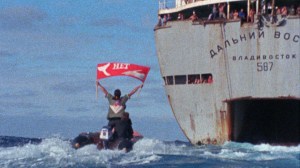 MD: I guess the technology itself, I think a lot of people are going to be surprised… I love the bit where they didn’t know if they actually got the shot of the harpoon because you had to wait until they develop the film.
MD: I guess the technology itself, I think a lot of people are going to be surprised… I love the bit where they didn’t know if they actually got the shot of the harpoon because you had to wait until they develop the film.
JR: Yeah we had a bit of discussion in the edit about how much we needed to tell people about how 16mm worked. The idea that you had to process footage cause of course there’s a whole generation now for whom the idea of processing material is kind of something from a distant past.
MD: Yeah.
JR: I think it’s a great, that moment of waiting to see a piece of film, it has a great sort of tension to it.
MD: Yeah. of course everything Is immediate these days, so it’s something that people aren’t used to these days. I’m not sure if you’re aware because of the history that Greenpeace has in New Zealand with the bombing of the Rainbow Warrior in the mid-80s.
JR: Yeah I mean, and going back earlier to the sort of, the French testing in Mururoa.
MD: Right. Right.
JR: The boat set off from New Zealand. It’s always going to be, I guess I sort of needed to make a decision about kind of…it was never going to be a sort of history of Greenpeace’s film, it’s always, I wanted to focus on this particular group who founded it and the natural kind of closure for that really was the point of which they have actually kind of give the thing they’ve created away to a larger, to the rest of the world, to an international group which happened in 79’. I was kind of tempted of like should I put the bombing of the Rainbow Warrior as a kind of coda? How might we include that? But in the end it felt like it was an incredible significant influence, an incredibly significant moment in Greenpeace’s history but it wasn’t that relevant to the film.
MD: I was wondering how you looked at the film, was it the film about the formation of the Greenpeace or about Bob Hunter himself?
JR: I mean I think, I felt as it was about a group of friends who set out to do something and kind of, almost by mistake create Greenpeace and that comes back to haunt them.
MD: Right.
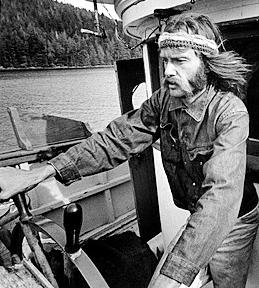
JR: With Hunter as the centre of it, absolutely. In a way the sort of emotional dilemmas of the film are the dilemmas of Hunter, dilemmas about leadership and about what to do and how to work with, how to bring people together, to work together.
MD: Yeah. And you got a great cast of characters, you couldn’t ask for a better bunch of people.
JR: Yeah, I mean it’s pretty extraordinary that that group of people were ever in the same organisation together. They’re all so different and they take such different approaches to action and they have very different sort of ideas about the world I guess.
MD: I think what draws them together is kind of this idealism that they had at that point in time and then eventually obviously they grow into their own way of expressing that I guess. Did you find yourself being drawn more to some characters than to others and kind of making…
JR: I mean it’s interesting that kind of, I think when you sort of spend a bit of time with people and then you spend a lot of time with them virtually watching the footage, I had about 40 hours of interviews I think all together and there’s something about that process that actually makes you really sort of warm to people because you start to really sort of understand the way they work because you’re kind of constantly kind of watching the way they speak or the way they respond. So I felt very warm about all of them I think and I wanted to sort of… in a way Greenpeace is a sort of contested history, there is a sort of disagreement about kind of what happened, what was the right thing to do and that carried forward In them till today and in a way you see those arguments kind of unfold in the present as well in the interviews. But yeah I mean I could, I think it’s important in something like this to make kind of everyone’s position sort of clear that you understand it from the inside and I think you can as much understand, say Pat Moore’s desire to kind of knock this organisation into shape at the point of which he took over for example as you can Paul Watson’s desire to just get out there and kind of ram some whalers.
MD: Right. It’s fantastic that you got both Paul Watson and Patrick Moore to take part in it. Was there any point which you thought maybe they wouldn’t contribute to interviews and things or were they quite willing to make their points?
JR: Yeah. I mean, I think they were, I think Paul especially would rather, he’s someone who’d far rather talk about present than the past. I think that’s sort of perhaps one of his qualities, he just forges forward.
MD: Right.
JR: But great that he, I think everyone felt very warm in a way towards him. The one thing everyone has in common is that sort of respect for and love of Bob.
MD: Right.
JR: And that was always a kind of, sort of driver in a way for the film and a motivation for people to get involved in a way Bob was the hub of the film and that was the reason for coming to get involved.
MD: Yeah. The 16mm footage…the whaling and the seal hunting…it’s still really powerful today. Do you think that, I get the feeling probably a lot of people haven’t seen that or at least not seen that or at least not seen it in a long time, footage that shows that. Is that going to have a renewed affect do you think on people’s thinking?
JR: Yeah I mean I think a lot of it hasn’t, a lot of it wasn’t used in the original film that Greenpeace made which was a sort of campaigning film about whaling. They certainly pulled back a lot of the graphic nature of that footage. For me certainly actually it kind of, I’ve never been a group member of Greenpeace. I think in the 70s when I was a teenager, my reaction was sort of the same as those in the film who say, what whales? What’s that got to do with anything?
MD: Right.
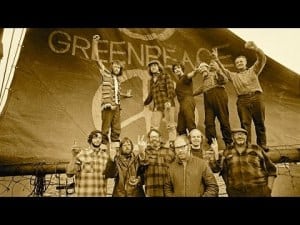 JR: When you sort of, when you see the footage, it’s incredibly dramatic on just a, and sort of gut wrenching on a visceral level?
JR: When you sort of, when you see the footage, it’s incredibly dramatic on just a, and sort of gut wrenching on a visceral level?
MD: Very difficult to watch.
JR: I think same with the seal material…I think the argument about the seal cull is a complex one which includes the impression about indigenous hunting which I’m hoping this have not gone out against indigenous hunters but obviously there’s the ban on the seal hunt has had a massive effect on…the ban on European imports of seal products had a big effect.
MD: Yeah.
JR: Yeah so those are complex issues but in a way the graphic nature of that image of just bludgeoning a baby seal kind of overwrites that completely doesn’t it.
MD: You use a motif of having 5 rules kind of going throughout. I was wondering if those were derived from Bob Hunter’s dairies or…
JR: Yeah. They all come, they all sort of, they all come broadly from Hunter’s writing. I mean he never sat down set them down as a set of rules but his writing is full of little kind of maxims or sentences that could easily be turned into… although I never really thought of them as a kind of how to guide, more as a kind of sort of ironic, sort of in a way questioning things to think about. I think Hunter was already kind of Zen about the way he kind of got to go through all this stuff and in a way they’re expressions of that.
MD: Yeah.
JR: But I think they all have a truth to them as well actually, that’s the idea you need to fail at success or let power go or put your body where your mouth is.
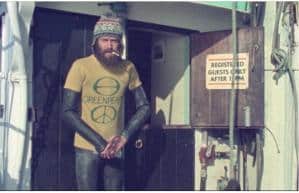 MD: And finally, at one point near the end of the film, Paul says Greenpeace, he believed, was more powerful when they had nothing instead of when they became bigger. Do you think that’s kind of an inherent philosophy about the way that, that kind of activism works? Is that relevant today?
MD: And finally, at one point near the end of the film, Paul says Greenpeace, he believed, was more powerful when they had nothing instead of when they became bigger. Do you think that’s kind of an inherent philosophy about the way that, that kind of activism works? Is that relevant today?
JR: I think it’s more…in the beginning, any group like that is more able to take risks, do more dramatic things, wind people up and all of those kinds of things. I think there’s, somewhere in one of the interviews I did I think Rex Wyler said you know you need an ecology of ecologists. You need the group that’s big enough to engage with governments about climate change regulations or sort of sit down at the table with the international whaling commission and you need the folks in a boat who are saying look over there, we’re not looking at what’s happening here.
MD: Yeah.
JR: And I think that’s true that these, social movements are sort of plural and in a way that’s what a lot of them fail to realise and why they end up in kind of, in-fighting. You need the sort of breadth of approach to sort of, I guess you need to fight on all fronts to win the battle.
Click here for more information about How To Change The World at the NZIFF.
Watch the trailer for How To Save The World here:[youtube https://www.youtube.com/watch?v=HFx9s3Ynzr0]
- Civil War – Dir: Alex Garland (Film Review) - April 9, 2024
- Pearl Jam – Dark Matter (Monkeywrench/Republic) Album Review - April 1, 2024
- Blonde Redhead – New Zealand Tour 2024 - March 14, 2024
